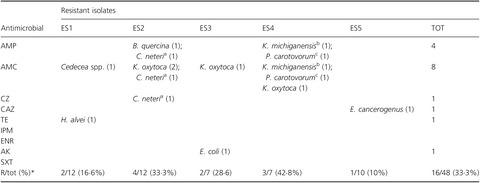当前位置:
X-MOL 学术
›
Lett. Appl. Microbiol.
›
论文详情
Our official English website, www.x-mol.net, welcomes your
feedback! (Note: you will need to create a separate account there.)
Could honey bees signal the spread of antimicrobial resistance in the environment?
Letters in Applied Microbiology ( IF 2.0 ) Pub Date : 2020-05-01 , DOI: 10.1111/lam.13288 S. Piva 1 , F. Giacometti 1 , E. Marti 1 , E. Massella 1 , R. Cabbri 1 , R. Galuppi 1 , A. Serraino 1
Letters in Applied Microbiology ( IF 2.0 ) Pub Date : 2020-05-01 , DOI: 10.1111/lam.13288 S. Piva 1 , F. Giacometti 1 , E. Marti 1 , E. Massella 1 , R. Cabbri 1 , R. Galuppi 1 , A. Serraino 1
Affiliation

|
The honey bee has long been known to be a bioindicator of environmental pollution and the use of antimicrobials in the beekeeping industry is strictly regulated. For these reasons, this paper was aimed to evaluate for the first time the role of Apis mellifera as a possible indicator of environmental antimicrobial resistance (AMR). The study isolated and analysed the resistance patterns of Enterobacteriaceae from a pool of honey bee guts located in five different environmental sites (ES), where different antimicrobial selective pressures were hypothesized. In all, 48 isolates were considered for identification and underwent analyses of AMR to ampicillin, amoxicillin/clavulanic acid, cefazolin, ceftazidime, tetracycline, imipenem, enrofloxacin, amikacin and trimethoprim/sulfamethoxazole. In all, 12 isolates out of 48 (25%) showed resistance to at least one antimicrobial drug. There were no significant differences between the resistance rates observed in the ESs, even if the highest percentage of resistance was found in ES4. Resistances to amoxicillin/clavulanic acid resulted significantly higher than those detected towards the other antimicrobials. Amoxicillin/clavulanic acid is not commonly used in beekeeping but it is extensively used in animals and in humans, suggesting an environmental origin of this resistance and supporting the hypothesis that honey bees could be used as indicators of AMR spread in the environment.
中文翻译:

蜜蜂能否发出抗菌素耐药性在环境中传播的信号?
众所周知,蜜蜂是环境污染的生物指标,养蜂业对抗菌剂的使用受到严格监管。由于这些原因,本文旨在首次评估蜜蜂作为环境抗菌素耐药性 (AMR) 可能指标的作用。该研究从位于五个不同环境地点 (ES) 的蜜蜂肠道池中分离并分析了肠杆菌科细菌的耐药模式,其中假设了不同的抗菌选择压力。总共有 48 个分离株被考虑进行鉴定,并进行了对氨苄西林、阿莫西林/克拉维酸、头孢唑啉、头孢他啶、四环素、亚胺培南、恩诺沙星、阿米卡星和甲氧苄啶/磺胺甲恶唑的 AMR 分析。在所有,48 株中的 12 株(25%)对至少一种抗菌药物表现出耐药性。即使在 ES4 中发现了最高百分比的抗性,在 ES 中观察到的抗性率之间也没有显着差异。对阿莫西林/克拉维酸的耐药性显着高于对其他抗菌剂检测到的耐药性。阿莫西林/克拉维酸不常用于养蜂业,但它广泛用于动物和人类,表明这种抗性的环境起源并支持蜜蜂可用作环境中 AMR 传播指标的假设。对阿莫西林/克拉维酸的耐药性显着高于对其他抗菌剂检测到的耐药性。阿莫西林/克拉维酸不常用于养蜂业,但它广泛用于动物和人类,表明这种抗性的环境起源并支持蜜蜂可用作环境中 AMR 传播指标的假设。对阿莫西林/克拉维酸的耐药性显着高于对其他抗菌剂检测到的耐药性。阿莫西林/克拉维酸不常用于养蜂业,但它广泛用于动物和人类,表明这种抗性的环境起源并支持蜜蜂可用作环境中 AMR 传播指标的假设。
更新日期:2020-05-01
中文翻译:

蜜蜂能否发出抗菌素耐药性在环境中传播的信号?
众所周知,蜜蜂是环境污染的生物指标,养蜂业对抗菌剂的使用受到严格监管。由于这些原因,本文旨在首次评估蜜蜂作为环境抗菌素耐药性 (AMR) 可能指标的作用。该研究从位于五个不同环境地点 (ES) 的蜜蜂肠道池中分离并分析了肠杆菌科细菌的耐药模式,其中假设了不同的抗菌选择压力。总共有 48 个分离株被考虑进行鉴定,并进行了对氨苄西林、阿莫西林/克拉维酸、头孢唑啉、头孢他啶、四环素、亚胺培南、恩诺沙星、阿米卡星和甲氧苄啶/磺胺甲恶唑的 AMR 分析。在所有,48 株中的 12 株(25%)对至少一种抗菌药物表现出耐药性。即使在 ES4 中发现了最高百分比的抗性,在 ES 中观察到的抗性率之间也没有显着差异。对阿莫西林/克拉维酸的耐药性显着高于对其他抗菌剂检测到的耐药性。阿莫西林/克拉维酸不常用于养蜂业,但它广泛用于动物和人类,表明这种抗性的环境起源并支持蜜蜂可用作环境中 AMR 传播指标的假设。对阿莫西林/克拉维酸的耐药性显着高于对其他抗菌剂检测到的耐药性。阿莫西林/克拉维酸不常用于养蜂业,但它广泛用于动物和人类,表明这种抗性的环境起源并支持蜜蜂可用作环境中 AMR 传播指标的假设。对阿莫西林/克拉维酸的耐药性显着高于对其他抗菌剂检测到的耐药性。阿莫西林/克拉维酸不常用于养蜂业,但它广泛用于动物和人类,表明这种抗性的环境起源并支持蜜蜂可用作环境中 AMR 传播指标的假设。











































 京公网安备 11010802027423号
京公网安备 11010802027423号